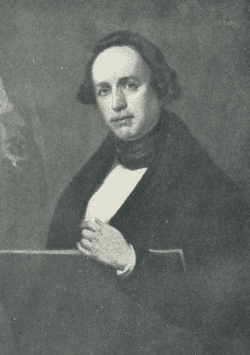Thomas James Mulvany, Landscape and Figure Painter
(b. 1779, d. 1845)
Landscape and Figure Painter
From A Dictionary of Irish Artists 1913

Thomas James Mulvany, R.H.A. Picture, by George F. Mulvany; in possession of Miss A. Mulvany, Dusseldorff.
Was born in Dublin in 1779, and learned his art as a pupil of Francis R. West in the Dublin Society's School, where he showed much proficiency as a figure draughtsman. He commenced as a miniature painter, and in 1802 sent eight miniatures to the exhibition in the Parliament House. He, however, abandoned miniature painting and devoted himself to figure compositions and landscapes, and was an exhibitor in 1810 and the four following years, and also in 1821. He was one of the most strenuous advocates for a charter of incorporation for the artists of Ireland; and when at length, in 1823, this was obtained and the Royal Hibernian Academy founded, he was chosen one of the fourteen original Members, and was appointed Keeper. He contributed to the Academy's first exhibition in 1826, and exhibited continuously until 1844, the year before his death, his contributions consisting of landscapes and subject pictures, with occasional portraits of horses. Among his works were "A Blind Beggar," 1826; "Peasants performing stations at Glendalough," 1829; and a "View at Dieppe with fish-wagons starting for Paris," 1826, which belonged to Francis Johnston, the architect, and was in his sale in 1845. Mulvany was a good draughtsman, but his work as a painter was mediocre, though esteemed in his time. He was favourably known as a teacher. He was a man of cultivated taste, with a considerable knowledge of the history of art, and a brilliant conversationalist, which made his society sought after. He contributed a series of articles upon some Irish artists to "The Citizen," containing much valuable information, though marred by diffuseness and long-winded and wearying disquisitions upon art.
It is said that he intended to produce a biography of Irish artists. He also edited a "Life of James Gandon," which was published a year after his death. In T. Bell's "Essay on the Origin and Progress of Gothic Architecture in Ireland," 1829, are two illustrations, "Armagh Cathedral" and "Ruins of St. Audoen's Church," drawn on stone by Mulvany. A picture by him of "The Descent of Thomas Livingston on the Coast of Baldoyle, 27 June, 1822, on which day he ascended from Portobello Barracks," was lithographed by Havell. Mulvany died of paralysis, after three days' illness, at his residence, Dirker Lodge, Cross Avenue, Booterstown, on 27th February, 1845, and was buried at Mount Jerome, where there is an inscription to his memory. He was father of John Skipton Mulvany, R.H.A., architect; of George F. Mulvany, R.H.A. and of William Thomas Mulvany, an engineer and for some time Commissioner of the Board of Works, who was born in 1806 and died at Dusseldorf on 30th October, 1885. The latter's son Thomas Robert Mulvany, was Consul at Dusseldorf for Westphalia, in the Rhenish provinces, and died in 1907.
« John George Mulvany | Contents and Search | Denis Brownell Murphy »
